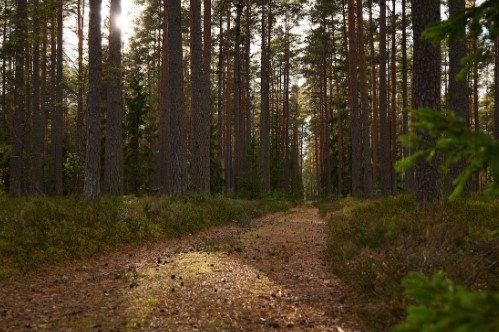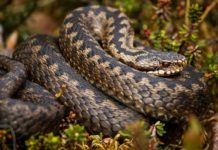There is a unique hole in the desert of Nullarbor Plain Caves. Immediately north of the Great Australian Bight, the large open bay on the south coast of Australia, lies the Nullarbor Plain, the largest single outcrop of limestone in the world, with an area of around 200,000 km². The limestone of this plain was laid down millions of years ago in a shallow sea, but geological activity forced the huge slab into its present position. This flat and treeless semiarid plain is far from inviting, but beneath its surface are treasures.
Limestone is dissolved slowly by rainwater, and over millions of years, any large area of this rock soon becomes riddled with caves and tunnels. This is exactly what has happened to the Nullarbor Plain, and its flat surface belies a network of caverns and tunnels, only a tiny proportion of which have been explored. In May 2002, a group of cavers found a sinkhole on the surface of the Nullarbor Plain—a sinkhole appears when the roof of a limestone cavity is dissolved, leaving a short pipe into the cavern beneath.
They decided to explore the sinkhole and lowered themselves through the 11-m pipe and into the cavern below. It was a further 20 m to the floor of the cavern, and when they shined their head torches on the rocks around their feet, they were met with a sight that no human had ever before seen. Around them, littering the floor of the cavern, were numerous skeletons. Some of the bones were semi-concealed by sediment, while others were lodged between rocks and boulders.
Obviously, these were not the remains of creatures that had died recently, and realizing the importance of their find, the cavers alerted the authorities. Following the discovery, a team of paleontologists and geologists visited the site and lowered themselves into the caves. It soon became clear to them that this was a very important find, probably one of the most significant paleontological discoveries on Australian soil. What lay before them was a more or less complete record of the animals that once stalked the Nullarbor Plain above their heads.
The remains of the animals were perfectly preserved, but they were fragile, and before any of the bones were removed, they were painted with a special strengthening compound. In total, 69 species of vertebrate were identified from the caves, many of which survive in Australia to this day. Twenty-one of the identified animals did not survive the Pleistocene and are known only from bones. Of the 23 species of kangaroo identified from the remains in the cave, no fewer than 8 were new species, which goes to show just how diverse Australia’s large animal fauna once was. One of the most interesting of these extinct kangaroos was a small species with bony protrusions above its eyes, like small horns.
Exactly what these were for is a mystery, but paleontologists have speculated that they protected the animal’s eyes from the spines of its food plants. Interestingly, two of the extinct kangaroos from the cave were tree-dwelling species, similar to the surviving rainforest kangaroos of New Guinea.
The site also yielded no fewer than 11 complete skeletons of the marsupial lion, an animal that was only previously known from a handful of skeletons. The largest animal in the assemblage was the extinct giant wombat, Phascolonus gigas, which, at 200 kg, goes to show that the sinkhole was quite some pitfall trap. All of the amazing animals the scientists discovered fell through the opening of the sinkhole and ended up on the chamber floor some 30 m beneath the surface.
Not many of the remains were found directly beneath the opening in the chamber ceiling, so it seems the fall was not fatal. Badly injured on the floor of the cave, the hapless animals crawled away into the darkness and died a slow death from their injuries and a lack of food and water. The scientists were finding the animals in the same positions in which they had died thousands of years previously, but when exactly had these animals fallen into the cave? Analysis of the sediments in the cave shows that the cavern was first opened to the surface about 790,000 years ago.
Over millennia, natural processes had sealed the sinkhole on numerous occasions, only for heavy rain and geological activity to open it again. It seems that the opening closed for the last time about 195,000 years ago, so what’s preserved at the bottom of this cave is a 600,000-year record of the animals that once lived in this part of Australia. These caves show not only how diverse the Australian megafauna was but also what the landscape and climate were like.
Today, the Nullarbor Plain is a relatively lifeless landscape, and the flora of the area is dominated by saltbush (Atriplex sp.) and bluebush (Maireana aphylla) scrub. Thousands of years ago, this was not the case, as trees and other plants, many of which have since disappeared, were common. Instead of the arid steppe we find today, the Nullarbor Plain was probably a mosaic of woodland and scrub, with plants that bore palatable leaves and fleshy fruits.
The fact that arboreal kangaroos have been recovered from the caves is proof that these plains supported large trees thousands of years ago. Interestingly, the climate of the ancient Nullarbor Plain was no different from what we see today, with average annual rainfall of around 180 mm. The drying of Australia’s climate is often cited as the cause of the extinction of the megafauna this huge island once supported.
The Nullarbor caves suggest otherwise. The animals and plants of Western Australia were well suited to arid conditions, and the disappearance of the bizarre beasts from this arid plain may be due to wildfires (natural or caused by humans) that wiped out many of the plant species, leaving the impoverished landscape we see today. With their food dwindling, the herbivores of the Nullarbor died out, closely followed by the predators and scavengers. Read More: Ubehebe Crater—Unique Geologic Features of Death Valley







